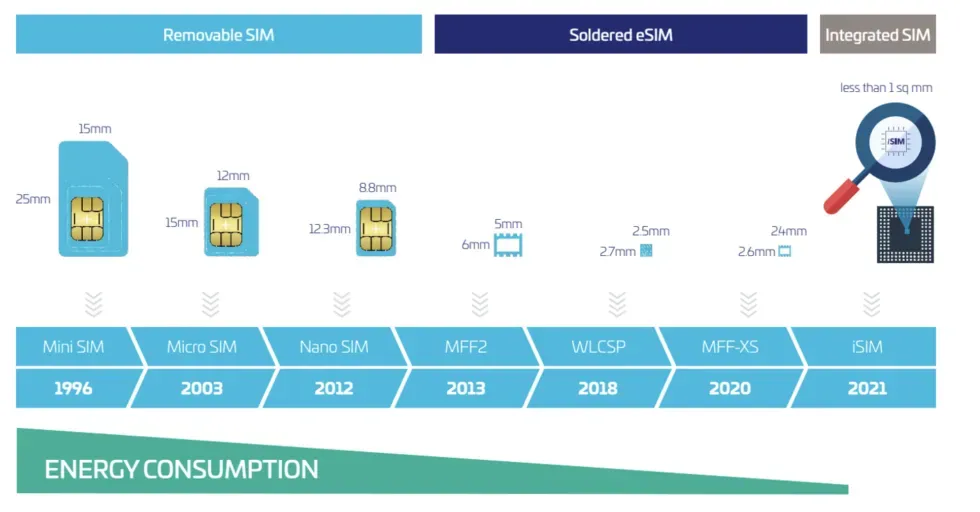Qualcomm wants to replace eSIM with iSIM, has first certified SoC

Here’s some exciting news from Mobile World Congress: Qualcomm says the Snapdragon 8 Gen 2 has been certified as “the world’s first commercially deployable iSIM (Integrated SIM)”. What is iSIM? Didn’t we just replace the SIM card with an eSIM? Yes, but iSIM is better than eSIM. We’ll explain, but in a nutshell, iSIM is the next step in the ongoing drive to make SIM cards smaller.
So, SIM cards (the smallest size “nano”) are small 12×9mm plastic cards that you physically insert into your phone. SIM card stands for “Subscriber Identity Module”and these cards basically just identify you to your cellular carrier, allowing you to set up your device for cellular service, which you pay a monthly bill for. The idea is that if you’re buying a new phone or have multiple phones, you can simply swap the SIM card and – as long as there are no compatibility issues – your service can be easily moved between phones.
In the old days, these cards held some of the actual data, such as contacts and messages, but with the advent of smartphones, all this has moved to the cloud. Today, a SIM card can store up to 265KB of data on this 12×9mm card, which is an absolutely terrible data density considering similarly sized MicroSD cards can store up to 1TB, or about 4.2 million times more data. SIM cards are a waste of space in an industry that is very aggressive about saving space, so they had to be abandoned.
Enter eSIM, the new standard that gets rid of the physical removable SIM card and instead solders a tiny chip to your phone’s motherboard. They appeared in the Google Pixel lineup in 2017, the iPhone in 2018, and some Samsung phones in 2021, and for some models, they lived alongside physical cards. In a major turning point for most carriers, Apple moved away from the physical SIM in 2022 with some iPhone 14 models and switched to eSIM only. An eSIM-only device does not have a removable card at all, and therefore no card slot, which simplifies the design of the device, saves space, and eliminates one possible place for water to enter. Instead of sticking a piece of plastic into your phone, you initialize your device through some kind of app, usually by logging into an account you have with your carrier. eSIMs are a big savings in size compared to physical cards, and the smallest chips are around 2.

eSIMs are still a chip that takes up space on your motherboard, and it’s not ideal if you want to squeeze every square millimeter of space out of your phone. The next reduction step is iSIM – Integrated Subscriber Identity Module. iSIMs are not integrated into a chip on the motherboard, but directly into the SoC. SoC (System on a Chip) integration is the technology that makes smartphones possible. Instead of thousands of little chips for things like CPU, GPU, RAM, modem and a bunch of other things, everything is packed into one versatile piece of silicon. Individual chips require more space and power due to the need to run traces on the motherboard to connect everything and deal with chip packs.
Building everything in one chip with the smallest transistors you can assemble is the cheapest, most compact and power efficient way to do things, and now SIM cards will disappear into this big block of things. iSIMs will be measured in fractions of a millimeter, and as part of SoCs, they will continue to shrink every year as chip processing nodes get smaller and smaller in nm. This seems to be the latest game for SIM technology, and in addition to helping phones, it will be great for space-constrained devices like smartwatches.
Of course, we need carriers on board, and that’s what Qualcomm’s announcement is basically about. The iSIM solution in SoC Snapdragon 8 Gen 2, which is already on sale, has been certified by GSMA, the world’s famous mobile operators. Qualcomm states that “the new iSIM is fully compliant with the GSMA Remote SIM Provisioning standard; this means that its subscriptions can be managed remotely through any standard platforms.” This is the same standard as the eSIM and it meets all the same security requirements, so in theory any operator working with an eSIM should see no difference between an eSIM and an iSIM. An iSIM is still just a piece of silicon that needs software – where the silicon lives shouldn’t matter much to your carrier.
Like many Qualcomm SoC components, the use of an iSIM is optional, even if it is built into the chip. All Snapdragon 8 Gen 2 phones currently use discrete eSIM chips instead of iSIMs. Now that the solution has been certified, it is expected that some phone manufacturer will build iSIM into the design of their next product.
Leave a Reply